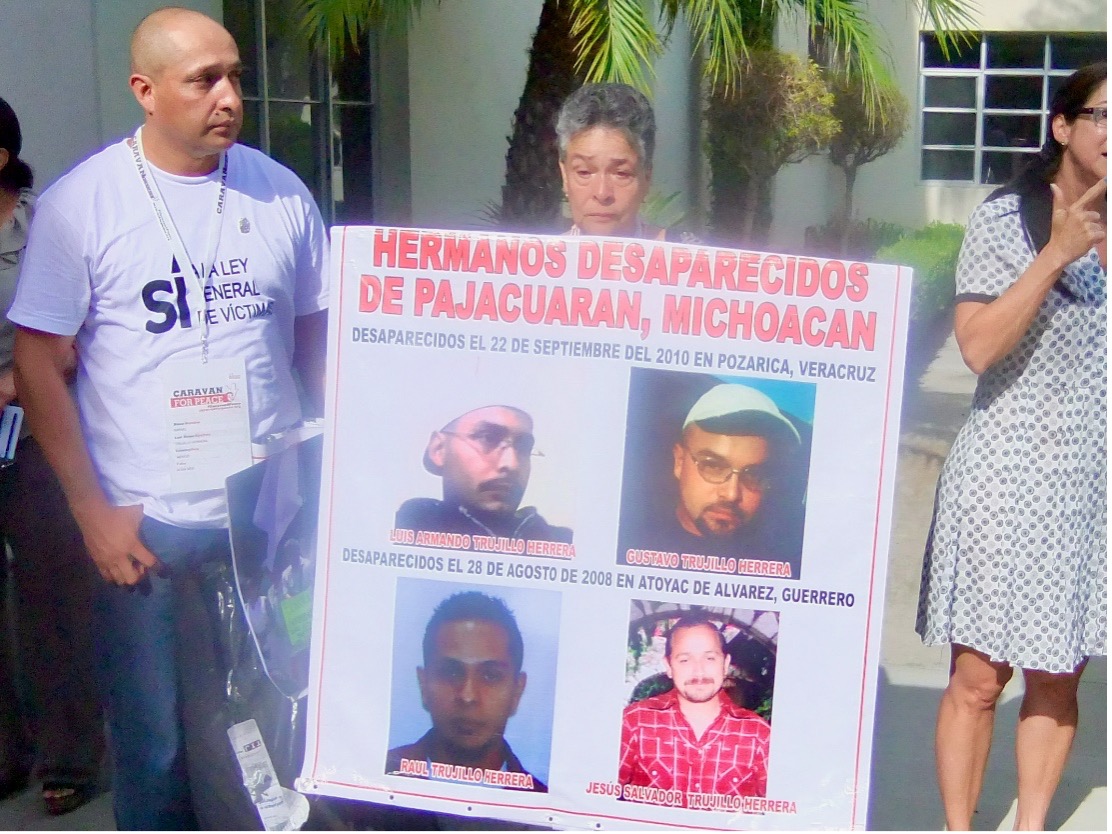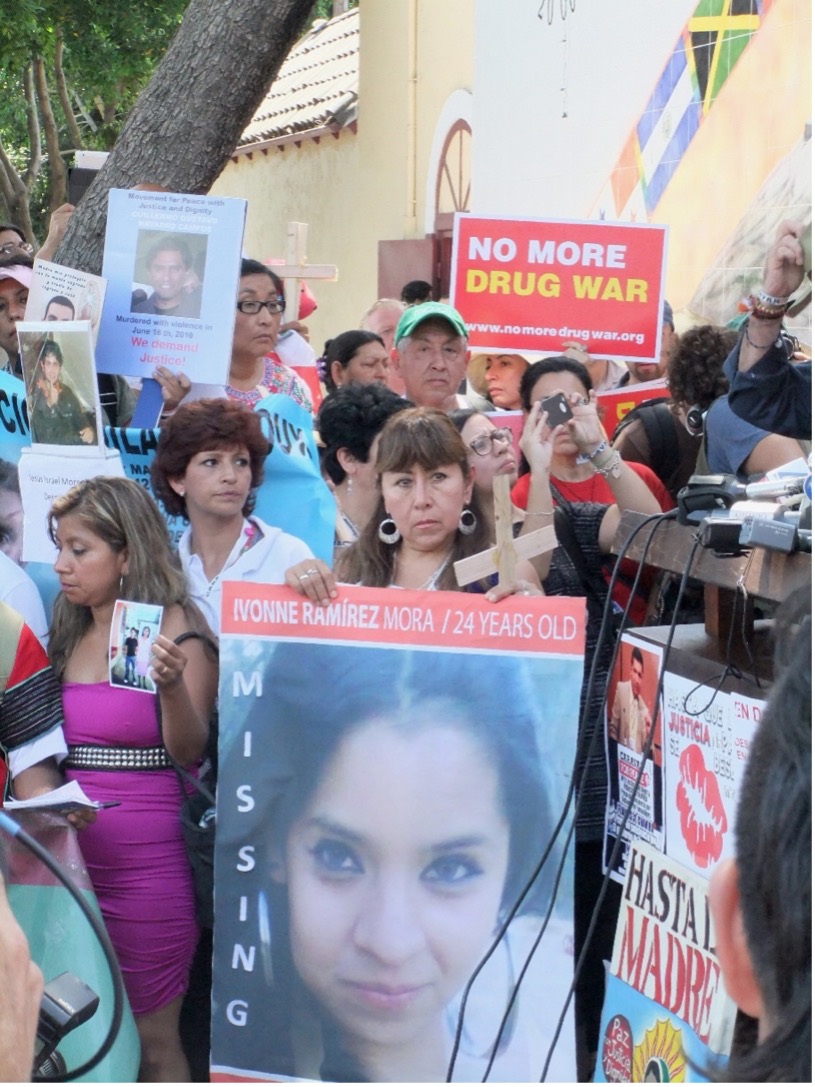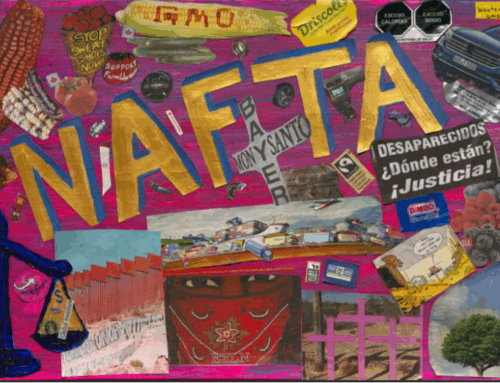Thirty years after NAFTA transformed Mexico’s economy, its entanglement with violence is unmistakeable. While these agreements were created to accelerate the movement of goods and capital across borders, they have also deepened impunity, militarized security, and unleashed forms of violence that mark everyday life in Mexico. One of the most harrowing is the phenomenon of disappearances.
Disappearances have long been a tool of state repression in Latin America and elsewhere, a practice with roots in the Cold War era when military governments covertly eliminated individuals deemed subversive. The term disappearances refers to the forced abduction of individuals. These acts are often carried out by state or non-state actors, and the victims’ whereabouts remain unknown, leaving families in anguish and uncertainty. While disappearances were once primarily politically motivated, the phenomenon has evolved in contemporary Mexico to encompass a broad spectrum of victims, from migrants and Indigenous people to professionals and human rights defenders. This shift reflects the structural entanglement of free trade agreements such as NAFTA and USMCA with violence and impunity.
Far from being merely a backdrop to Mexico’s crisis of disappearances, these trade agreements have actively facilitated the conditions under which violence thrives. By prioritizing economic liberalization, reducing state oversight, and fostering the integration of legal and illegal economies, NAFTA and USMCA have created a landscape in which criminal organizations flourish, state accountability weakens, and vulnerable populations bear the heaviest burden. These agreements’ emphasis on deregulation and trade efficiency has not only reshaped Mexico’s economy but also embedded violence and disappearance into its social fabric.
This essay explores how free trade agreements such as NAFTA are intrinsic to the production of violence and disappearance, rather than incidental to them. Through the stories of those directly impacted, such as grassroots activist María Herrera Magdaleno and trucker El Chivo, it examines how trade policies enable organized crime, weaken the state, and drive systemic impunity. It also shows how grassroots movements emerge as critical counterpoints to this structural neglect.
Mexico’s Crisis of Disappearances
In August 2008, María Herrera Magdaleno, a mother of eight from Michoacán, faced the devastating disappearance of her sons Raúl and Jesús Salvador during a business trip to Guerrero. Just two years later, two more sons, Gustavo and Luis Armando, went missing in Veracruz while searching for their missing brothers. Like many families in Mexico, María encountered not only the profound human toll of disappearance but also the indifference and corruption of state institutions.
The disappearances of María’s sons cannot be disentangled from the economic and political conditions shaped by neoliberal trade policies. Guerrero and Veracruz, regions critical to Mexico’s export economy, have experienced increasing criminal activity tied to extortion, resource exploitation, and drug trafficking, dynamics directly linked to the economic liberalization initiated under NAFTA. The opening of trade routes created channels not only for goods but also for illicit activities, as cartels exploited the infrastructure and financial flows established by free trade. Meanwhile, state institutions, weakened under austerity measures, have become either complicit in these crimes or incapable of addressing them.
Faced with systemic inaction, María channeled her grief into determined activism, founding a network of nearly 200 collectives across 26 states. These grassroots organizations, many led by mothers like María, conduct searches for clandestine graves, advocate for governmental accountability, and educate families on investigating disappearances. Their efforts highlight the resilience of those most affected by violence and reveal how state neglect has created spaces for community-based resistance. Yet this resistance operates in the shadow of policies that prioritize economic liberalization and the protection of corporate interests over human lives.
María’s story is deeply entwined with grassroots resistance, efforts in which her remaining sons have also played a pivotal role. It illustrates the profound human cost of Mexico’s disappearance crisis and underscores the essay’s central argument: that free trade agreements such as NAFTA and USMCA, with their emphasis on economic efficiency and deregulation have not only enabled criminal enterprises to thrive but have also weakened state mechanisms of justice and accountability.

Figure 1. María Herrera stands with her son Rafael and photos of her four other missing sons, in Los Angeles, 2012. Photo by author.
NAFTA’s Role in Shaping Violence
NAFTA is often celebrated for invigorating trade and economic growth, but its policies also entrenched conditions that fuel violence and impunity. The liberalization of trade routes created channels that traffickers quickly exploited, using the same infrastructure designed for legal commerce to move illicit goods. As Peter Andreas (2000) observes, the blurred lines between legal and illegal economies under NAFTA exemplify how free trade agreements can inadvertently strengthen organized crime.
El Chivo, a truck driver I met during fieldwork, offers a telling example. As trade increased under NAFTA, the volume of trucks crossing the U.S.-Mexico border tripled, overwhelming inspection systems and leaving exploitable gaps. El Chivo described how truckers were often unknowingly used as “blind mules,” with traffickers concealing drugs in their rigs and retrieving the loads later without the drivers’ knowledge. The precarious conditions faced by drivers led some to knowingly accept smuggling jobs for higher pay, further embedding criminal activity into Mexico’s export economy.
These dynamics were not limited to illicit goods. High-value legal exports such as avocados and limes also became lucrative for cartels seeking profits through extortion and control over supply chains. This entanglement of legal and illegal economies underscores NAFTA’s structural contradictions: while the agreement aimed to liberalize trade and stimulate economic growth, it also escalated drug prohibition efforts, creating overlapping systems of commerce and control. This tension culminated in the Mérida Initiative of 2007, which ostensibly sought to combat organized crime but largely served to protect U.S. economic interests. Despite increased militarization under the Mérida Initiative, cartel incursions into export economies have persisted, illustrating how policies designed to secure trade have instead deepened violence.
The Trump administration’s tariff wars of 2025, justified in the name of national security, border control, and the promise of bringing jobs back to the U.S., did not disrupt these violent entanglements but instead deepened them. Sweeping duties on Canadian and Mexican goods unsettled regional supply chains, producing volatility that corporations absorbed by displacing risk onto workers, migrants, and small producers. These tariffs were not a corrective to the harms of NAFTA and USMCA but their continuation: another instance of U.S. trade policy functioning as coercion. Whether through deregulated flows of goods or their sudden restriction, North American trade regimes perpetuate instability and precarity. Both free trade and protectionist tariffs embed forms of violence that prioritize U.S. economic and political power over human lives. This exposes the central paradox of these trade agreements: they promise economic growth while eroding state accountability, entrenching violence and impunity as features of the neoliberal order.
Violence Fueled by Free Trade
Far from solely promoting economic growth, free trade agreements such as NAFTA and USMCA have fostered conditions in which violence and disappearance thrive. By opening trade routes and weakening state institutions through austerity measures, these agreements facilitated not only legal commerce but also the expansion of organized crime.
Disappearances, once tools of targeted political repression, have become widespread and seemingly random, fostering a pervasive regime of fear. This unpredictability functions as a form of social control, instilling terror while enabling state and nonstate actors alike to maintain power through violence and impunity. At the same time, corporations and financial institutions benefit from this instability. They profit through access to cheap labor, resource exploitation, or financial flows linked to money laundering. As Dawn Paley (2015) argues, banks and transnational corporate interests profit from systemic violence, reaping rewards from the very instability that devastates vulnerable communities.
This entanglement of trade and violence is not incidental—it is structural. Disappearances ensure compliance with an economic system that prioritizes profit over human life, whether through the forced displacement of communities, the exploitation of workers in maquiladoras, or the violent suppression of resistance movements. Far from being collateral damage, the victims of this violence, disproportionately from marginalized communities, are central to the functioning of this economic order, highlighting the human cost of neoliberal economic policies.

Figure 2. A mother stands with the image of her disappeared daughter, Ivonne, at a rally in Los Angeles, 2012. Photo by author.
Neoliberalism and Marginalized Communities
Free trade agreements such as NAFTA and USMCA have intensified inequality in Mexico, with Indigenous communities, women, and LGBTQ individuals bearing the brunt of displacement, exploitation, and violence. These harms reflect a neoliberal economic model that prioritizes profit over protections for vulnerable populations.
For Indigenous communities, trade agreements have facilitated the encroachment of corporate interests into ancestral lands. In regions such as Oaxaca and Chiapas, mining, agriculture, and energy projects have displaced entire communities, disrupting traditional livelihoods and exposing residents to violence from both state and nonstate actors. This forced displacement is not a byproduct of economic liberalization but a mechanism through which it operates, as the extraction of resources for export markets depends on removing local resistance.
Women employed in maquiladora zones like Ciudad Juárez have also experienced the intensified effects of neoliberal restructuring. These low-wage manufacturing hubs, central to NAFTA’s model of economic growth, have exacerbated gendered vulnerabilities. Women workers face precarious labor conditions alongside heightened risks of gender-based violence, including femicide. While such violence predates NAFTA, the agreement entrenched the structural inequalities that sustain it, transforming the border into a global assembly line where women are both exploited as laborers and targeted as victims (Fernandez-Kelly 1983; Wright 2006). Similarly, LGBTQ individuals (particularly trans women) contend with systemic discrimination compounded by economic precarity, making them especially vulnerable to violence and disappearance.
These patterns reflect a broader logic of exclusion and exploitation underpinning free trade. By integrating legal and illegal economies, NAFTA created conditions in which marginalized groups face systemic neglect and heightened risks of violence, as traffickers exploited trade routes and financial systems designed for cross-border commerce. Yet within this environment, local movements led by these same communities have emerged as critical forces of resistance. Indigenous activists defending their lands and women’s collectives demanding accountability have become vital counterpoints to the impunity sustained by free trade policies, revealing both the resilience and agency of those most affected by these systemic injustices.
Ethnography and NAFTA’s Impacts
Ethnographic methods are crucial for understanding how free trade agreements such as NAFTA intersect with violence and disappearance in ways often obscured by official narratives and aggregate data. Ethnography reveals the lived experiences and systemic injustices that underpin these phenomena.
One of ethnography’s most vital contributions is its ability to challenge the criminality narrative often attached to victims of violence and disappearance. State and media discourses frequently frame disappearances as the inevitable result of criminal conflicts, obscuring the systemic drivers of violence, including economic policies that enable organized crime and weaken state accountability. Through close engagement with affected individuals and communities, ethnographic research disrupts this narrative, showing that victims are often ordinary people caught in the crossfire of larger structural forces.
The stories of María Herrera and El Chivo illustrate the deeply intertwined nature of free trade policies and violence in Mexico. NAFTA and USMCA, while designed to stimulate economic growth, have also created conditions that foster impunity, weaken state institutions, and entangle legal and illegal economies. As scholars like Dawn Paley (2015) and Verónica Gago (2017) argue, these policies do more than shape economic systems—they reshape everyday life, embedding violence into the social fabric.
Ethnography also amplifies the resilience and resistance of those most affected by systemic neglect. Community based movements, led by individuals like María, offer a counterpoint to this neglect. Yet these efforts exist within a broader framework of economic liberalization that prioritizes corporate interests over human lives. Only by amplifying these lived experiences and exposing systemic injustices can we begin to challenge the impunity embedded in free trade policies and reimagine more equitable frameworks.
References
Andreas, Peter. 2000. Border Games: Policing the U.S.-Mexico Divide. Ithaca: Cornell University Press.
Fernandez-Kelly, Patricia. 1983. For We Are Sold, I and My People: Women and Industry in Mexico’s Frontier. Albany: State University of New York Press.
Gallagher, Janice. 2023. Bootstrap Justice: The Search for Mexico’s Disappeared. Oxford University Press.
NACLA. 2024. Dónde Están? Vol. 56, No. 2.
Paley, Dawn. 2015. Drug War Capitalism. Oakland: AK Press.
Wright, Melissa W. 2006. Disposable Women and Other Myths of Global Capitalism. New York: Routledge.
Gago, Verónica. 2017. Neoliberalism from Below: Popular Pragmatics and Baroque Economies. Durham: Duke University Press.
Shaylih Muehlmann is a Professor of Anthropology at the University of British Columbia. She is the author of Where the River Ends: Contested Indigeneity in the Mexican Colorado Delta (Duke University Press, 2013), When I Wear My Alligator Boots: Narco-Culture in the U.S.-Mexico Borderlands (University of California Press, 2013) and Call the Mothers: Searching for Mexico’s Disappeared in the War on Drugs (University of California Press, 2024)
Cite as: Muehlmann, Shaylih. 2025. “Free Trade, Bound by Violence”. In “Anthropology of Free Trade”, edited by Alejandra González Jiménez, American Ethnologist website, 11 November. [https://americanethnologist.org/online-content/free-trade-bound-by-violence-by-shaylih-muehlmann/]




